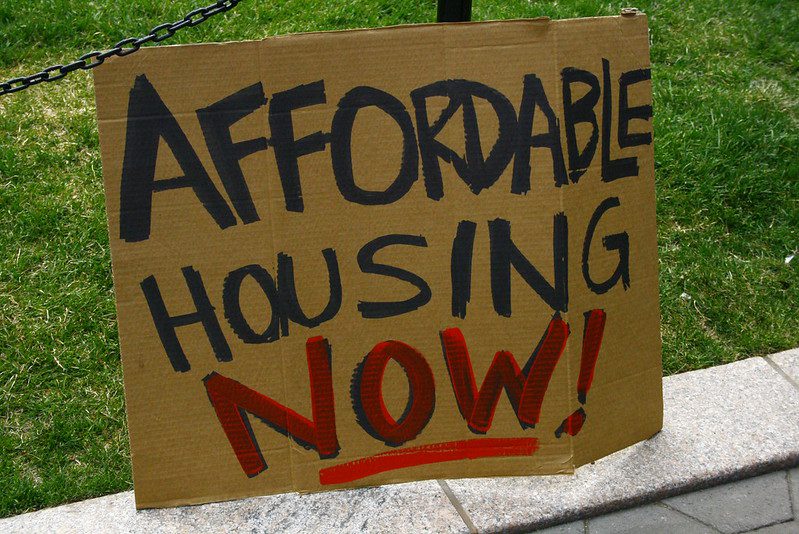Boom – The Sound of Eviction (96 minutes, 2002), a documentary directed by Francine Cavanaugh, A. Mark Liiv, and Adams Wood. Individuals $20 donation + $3 postage; institutions $200 + $3 postage. Whispered Media, P.O. Box 40130, San Francisco, CA 94140. www.boomthemovie.org.
For anyone involved in tenant and community organizing over the last three decades, Boom tells a familiar tale. Gentrification was an issue 30 years ago, just as it is today in the Mission District of San Francisco, except back then it wasn’t dot-comers displacing low-income families. Still, for those of us who have worked on these issues for many years, it’s a story we know well.
The documentary opens with the implosion of Geneva Towers – 576 public housing apartments – in 1997. It was a harbinger of what was to come, as technology stocks soared and new money flooded the Silicon Valley. In 1998, the San Francisco Bay Guardian published an article, “The Economic Cleansing of San Francisco,” about the impact of all that money on the city (see SF #102). “What we didn’t know was that was the beginning,” says a Bay Guardian reporter. Old newsreels extolling San Francisco as a “city of destiny,” and movie clips about the city’s gold rush and the stock market frenzy of the 1920s make the point that the dot-com boom was just the latest in a long line of money-making crazes to hit the city and the nation.
When the film fast forwards to the present, it shows us the confident young people who flocked to the city and its environs to be part of what everyone called “the new economy.” Michael Perkins, a co-author of a 1999 book, The Internet Bubble, that predicted the demise of the new economy, says in the film that of the $20 billion in venture capital for technology flowing into the system, about $7.5 billion made its way into the Bay area alone. The impact on the Mission District, long a community of working class Irish, Italian, and later Mexican and Central American immigrants, was immediate. Renee Saucedo, director of the San Francisco Day Labor Program, calls it “an invasion of wealthier tenants.” In addition to low-income residents, the mom and pop stores that give a community its character, convenience, and continuity were being forced out by higher rents. Cultural institutions were not immune: A dance studio that was in the Mission for 18 years saw its rent go from $6,000 to $12,000 a month. The film inevitably raises the question: Who does the city serve – residents or speculators who want to draw wealthier tenants?
Unfortunately, Mayor Willie Brown was no ally for those seeking to hold on to their homes and community. Brown says in an interview that the changes befalling the Mission District are “the natural process,” adding that the Mission “wasn’t always Latino, it was Irish,” as if ethnicity and not economics was the point. He even says the Latinos protesting the changes “don’t represent the community,” ignoring his constituency and their grievances.
The community was not giving up without a fight, of course. San Francisco’s long history of activism is recapped – from the general strike of 1934 that saw 127,000 people shut the city down for four days to the battles of the 1970s to save a residential hotel and prevent changes to the transit system that would harm the Mission (see SF #107). Current residents of the Mission were no less vocal. They mobilized demonstrations, crashed a dot-com party to confront the moneyed newcomers, and delivered a tree studded with pictures of neighborhood children, to a landlord in his store, pleading “don’t uproot us.” An “accountability session” with city officials drew 500 residents. One family that was threatened with eviction won their fight, but the dance studio was eventually evicted.
But as the film makes clear, the struggle is not just about the dot-coms, it’s also about the growing number of laws and regulations that ease the way for landlords who want to oust long-time tenants for higher-paying ones. For example, no-cause evictions in Oakland allow landlords to legally evict a tenant – for no reason – with just 30 days notice. Community organizers in that city are trying to get a just cause ordinance passed that would require landlords to provide a valid reason, such as failure to pay rent, drug dealing, and other illegal activities before they evict tenants. San Francisco, Berkeley, and other California cities have passed just cause ordinances.
Boom ends as we know it will, with the bursting of the dot-com bubble and the tanking of the economy. But the damage has been done, and the Mission’s identity has been changed. Many of the artists and Latinos who called the Mission home have been scattered to other neighborhoods. The site of the dance studio is vacant, and other building projects that displaced hundreds of people have been aborted. The film tells a compelling story that will unfortunately resonate for many other communities. And it’s a great answer to those who question the need for direct action and tenant protections.



Comments